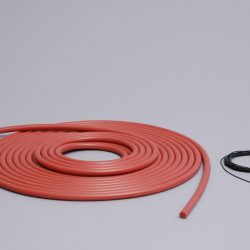Rubber sealing cords are commonly used profiles made of extruded homogeneous rubber. We offer them in round and square profiles, with the choice of the right type depending on the specific application. These cords are produced by extruding and vulcanizing a rubber mixture.
Rubber sealing cords made of NBR:
This material is characterized by its black color. The cords are available in round and square profiles, with a hardness of 70 Shore. They are resistant to temperatures ranging from -40 to +110°C, and can withstand steam up to 130°C for short periods. They are suitable for aliphatic hydrocarbons (e.g. propane, butane, gasoline) and mineral oil-based lubricants.
Rubber sealing cords made of EPDM:
EPDM rubber cords are dark in color and are available in round profiles, with a hardness of 70 Shore. This material withstands temperatures between -40 and +140°C, and when in contact with steam the temperature should not exceed 130°C. The cord is resistant to inorganic and organic substances, oxidants, alkalis and ketones.
Rubber sealing cords made of VMQ (silicone):
This variant is light in color. They are available in round and square profiles, with a hardness of 70 Shore. The material withstands temperatures between -50 and +150°C, but when sealing water vapor the temperature should not exceed 120°C. These cords are ideal for high temperatures and food-related applications. They are non-conductive and alcohol-resistant.
Rubber sealing cords made of FPM (FKM):
FPM sealing cords are produced in various colors. They are available in a round profile and have a hardness of 70 Shore. This material can withstand temperatures from -20 to +200°C. When exposed to water vapor, the temperature should not exceed 140°C to prevent premature wear. These cords are resistant to mineral, vegetable and animal oils as well as some additives and fuels.
Material specification
Principal factors for the material selection are pressure, temperature, and packed medium.
| Material | Temperature range | Usage | Hardness |
|---|---|---|---|
| NBR Acrylnitrile-Butadiene-Rubber | – 30 °C + 110 °C | standart material for hydraulic and pneumatic compression fluid on mineral-oil base animal and vegetable oils heavily inflame fluids, aliphatic hydrocarbons (propane,butane,gas) silicon oils water up to +80°C, air, bio-oils, from synthetic ester and vegetable oils | 70 |
| EPDM Ethylene-Propylene-Dien-Rubber | – 60 °C + 150 °C | hot water, vapour, brake fluid, washing means alcohols, ketones, KFZ-cold water heavily inflame fluids on the phosphorus-acid base organic and anorganic acids and bases | 70 |
| Silicone | – 70 °C + 230 ° | hot air, oxygen, ozone, UV-rays aliphatic engine and transmission oils, animal and vegetable oils brake fluids | 60 |
| FPM Fluorine-Rubber | – 20 °C + 260 °C | mineral oils aliphatic, aromatic and chlorine hydrocarbons gas, super-gas, diesel-propellants heavily inflame fluids on phosphate-ester base, silicon oils acids, lyes | 70 |
Standard types:
NBR 70 and FPM 70 materials
Size toleration
| NBR material | |
|---|---|
| cord diameter in mm | toleration in mm |
| 1,5 – 2,0 | ± 0,2 |
| 2,1 – 3,0 | ± 0,25 |
| 3,1 – 4,0 | ± 0,35 |
| 4,1 – 6,0 | ± 0,4 |
| 6,1 – 10,0 | ± 0,55 |
| 10,1 – 16,0 | ± 0,65 |
| 16,1 – 24,0 | ± 0,85 |
| 24,1 – 30,0 | ± 1,00 |
| FPM material | |
|---|---|
| cord diameter in mm | toleration in mm |
| 1,5 – 2,5 | ± 0,2 |
| 2,6 – 3,0 | ± 0,25 |
| 3,1 – 6,0 | ± 0,3 |
| 6,1 – 10,0 | ± 0,4 |
| 10,1 – 16,0 | ± 0,5 |
| 16,1 – 25,0 | ± 0,7 |
| 25,1 – 30,0 | ± 0,9 |
For more information about the availability of your desired rubber cords, please do not hesitate to contact us.

